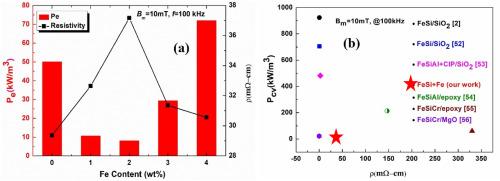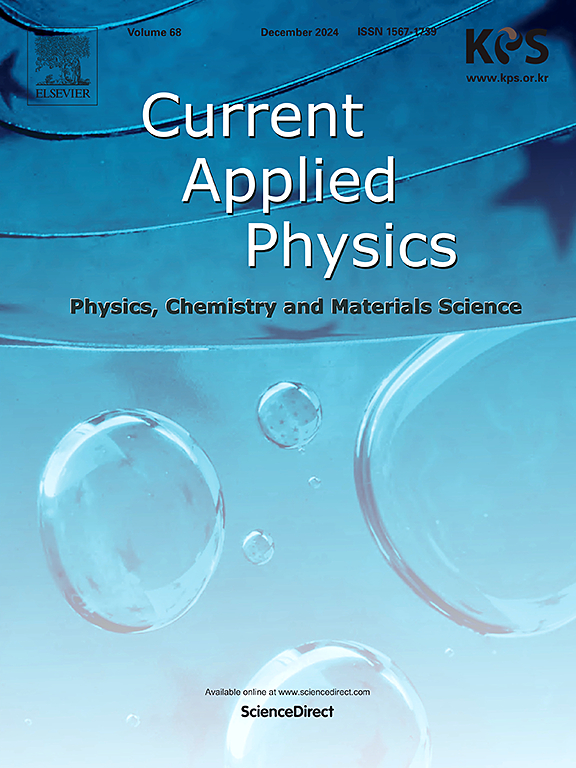采用TiO2和Fe纳米粉末气隙填充热压烧结FeSi软磁复合材料,降低了磁芯损耗,提高了磁导率稳定性
IF 3.1
4区 物理与天体物理
Q3 MATERIALS SCIENCE, MULTIDISCIPLINARY
引用次数: 0
摘要
软磁材料是电动机、发电机、变压器和许多电子设备中必不可少的部件。本文研究了采用热压烧结方法合成的Fe-6.5 wt%Si/(TiO2:Fe)(纳米粉末;NP)软磁复合材料(SMC)芯,其不同浓度的Fe纳米粉末(0-4 wt%)的软磁性能得到改善。随着Fe纳米粉浓度的增加,载流子的密度和电阻率分别通过填充气隙和晶界散射而显著增加。此外,加入铁纳米粉后,矫顽力显著降低(<15 Oe),饱和磁化强度显著提高(189.5 emu/g)。值得注意的是,FeSi/(TiO2:Fe)(NP) SMCs表现出优异的软磁特性,包括高磁导率和良好的频率稳定性,频率范围在0 ~ 1 MHz之间,并且在掺铁浓度为2 wt%时涡流损耗极低(8.16 kW/m3下降了83.47%)。添加3 wt%铁纳米粉的复合材料的磁滞损失Ph值显著降低,最小值约为0.677 kW/m3。因此,适当加入Fe纳米粉,结合热压烧结技术,可以有效降低铁芯损耗,特别是涡流损耗,表明以FeSi为基体的Fe NP复合材料在高功率和高频电子应用中具有很大的前景。本文章由计算机程序翻译,如有差异,请以英文原文为准。

Extremely low core-loss and enhanced permeability stability in hot press sintered FeSi soft magnetic composites by TiO2 and Fe nanopowders air gap filling
Soft magnetic materials are essential components in applications of motors, generators, transformers, and many electronic devices. Here we present the improved soft magnetic properties in Fe-6.5 wt%Si/(TiO2:Fe)(nano powder; NP) soft magnetic composite (SMC) cores with varying concentrations of Fe nanopowders (0–4 wt%) synthesized by hot-press sintering. Increasing Fe nanopowder concentration significantly increases the density and electrical resistivity by filling the airgap and grain boundary scattering of carriers, respectively. Furthermore, adding Fe nanopowders leads to remarkably low coercivity (<15 Oe) and high saturation magnetization (189.5 emu/g). Notably, the FeSi/(TiO2:Fe)(NP) SMCs exhibited excellent soft magnetic characteristics, including high permeability with good frequency stability ranging from 0 to 1 MHz and ultra-low eddy current loss (8.16 kW/m3 decreased by 83.47 %) at the 2 wt% doping concentration of Fe nanopowder. The composite with 3 wt% Fe nanopowder showed a significant decrease in hysteresis loss Ph with a minimum value of around 0.677 kW/m3. Therefore, the appropriate incorporation of Fe nanopowders, combined with the hot-press sintering technique, effectively reduces core loss, particularly eddy current loss, indicating that the Fe NP composites with FeSi matrix are highly promising for high-power and high-frequency electronic applications.
求助全文
通过发布文献求助,成功后即可免费获取论文全文。
去求助
来源期刊

Current Applied Physics
物理-材料科学:综合
CiteScore
4.80
自引率
0.00%
发文量
213
审稿时长
33 days
期刊介绍:
Current Applied Physics (Curr. Appl. Phys.) is a monthly published international journal covering all the fields of applied science investigating the physics of the advanced materials for future applications.
Other areas covered: Experimental and theoretical aspects of advanced materials and devices dealing with synthesis or structural chemistry, physical and electronic properties, photonics, engineering applications, and uniquely pertinent measurement or analytical techniques.
Current Applied Physics, published since 2001, covers physics, chemistry and materials science, including bio-materials, with their engineering aspects. It is a truly interdisciplinary journal opening a forum for scientists of all related fields, a unique point of the journal discriminating it from other worldwide and/or Pacific Rim applied physics journals.
Regular research papers, letters and review articles with contents meeting the scope of the journal will be considered for publication after peer review.
The Journal is owned by the Korean Physical Society.
 求助内容:
求助内容: 应助结果提醒方式:
应助结果提醒方式:


